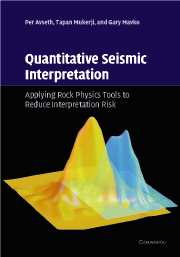Book contents
- Frontmatter
- Contents
- Preface
- 1 Introduction to rock physics
- 2 Rock physics interpretation of texture, lithology and compaction
- 3 Statistical rock physics: Combining rock physics, information theory, and statistics to reduce uncertainty
- 4 Common techniques for quantitative seismic interpretation
- 5 Case studies: Lithology and pore-fluid prediction from seismic data
- 6 Workflows and guidelines
- 7 Hands-on
- References
- Index
- Plate section
7 - Hands-on
Published online by Cambridge University Press: 27 January 2010
- Frontmatter
- Contents
- Preface
- 1 Introduction to rock physics
- 2 Rock physics interpretation of texture, lithology and compaction
- 3 Statistical rock physics: Combining rock physics, information theory, and statistics to reduce uncertainty
- 4 Common techniques for quantitative seismic interpretation
- 5 Case studies: Lithology and pore-fluid prediction from seismic data
- 6 Workflows and guidelines
- 7 Hands-on
- References
- Index
- Plate section
Summary
For the things we have to learn before we can do them, we learn by doing them.
AristotleIntroduction
This chapter provides problem sets and an extended reservoir characterization project based on an example seismic data set and well logs provided at the book website. The website also has additional resources in the form of downloadable matlab function files that may be helpful in solving the problems. We used the matlab statisti cs toolbox and neural net toolbox for solving the problems involving pdf estimation and statistical classification.
Well-log data from five wells are provided in flat ascii text files. Well 2 is taken as the type-well. Six different lithofacies have been identified from Well 2. For the purposes of the problem sets and the project the facies are: clean sand, cemented sand, silty-sand1, silty-sand2, silty-shale, and shale. The depth zones containing data for these facies have been extracted from Well 2 and provided in separate text files. The seismic data consist of one 2D section of NMO-cor rected pre-stack CDP gathers, and two 3D cubes of near- and far-offset partial stacks. Details about the seismic data and well locations within the seismic cubes are provided below in Section 7.3.
Problems
Rock physics modeling
Load the well-log data for Well 2 into your software of choice (matlab, Excel or any other suitable software). The ascii file contains five columns: depth, VP, density, gamma ray, and VS.
Information
- Type
- Chapter
- Information
- Quantitative Seismic InterpretationApplying Rock Physics Tools to Reduce Interpretation Risk, pp. 332 - 339Publisher: Cambridge University PressPrint publication year: 2005
